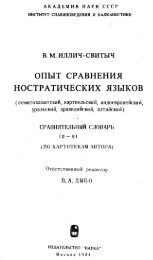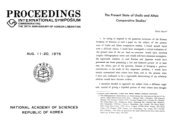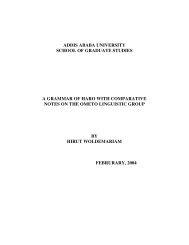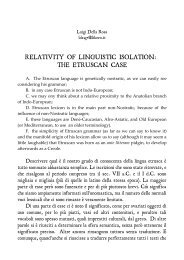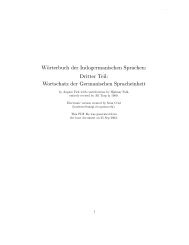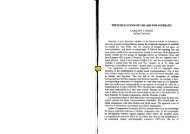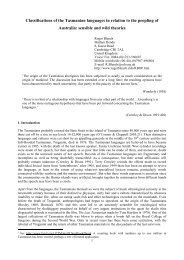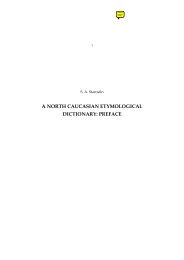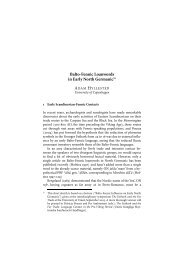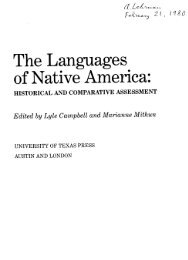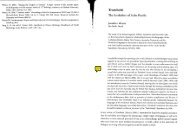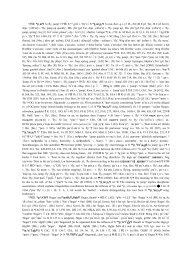The Indo-European Elements in Hurrian
The Indo-European Elements in Hurrian
The Indo-European Elements in Hurrian
You also want an ePaper? Increase the reach of your titles
YUMPU automatically turns print PDFs into web optimized ePapers that Google loves.
1. Introduction 3<br />
Urartian parent language, probably located to the northeast of Mesopotamia <strong>in</strong> the foothills of the<br />
Caucasus Mounta<strong>in</strong>s and dated to before the third millennium BCE. Diakonoff (1957:39)<br />
concludes that “Urartean is not a late dialect of <strong>Hurrian</strong>, but a separate language derived from<br />
one parent with the latter and <strong>in</strong> some respects preserv<strong>in</strong>g more archaic features than the <strong>Hurrian</strong><br />
language.” Urartian rema<strong>in</strong>ed spoken long enough for Armenian to borrow a few words with<br />
fairly clear Hurro-Urartian orig<strong>in</strong>. Diakonoff (1961:597) even suggests that the autoethnonym<br />
of the Armenians Haykh derives from *Àathyos, a variant of Àatti.<br />
Though attempts have been made to f<strong>in</strong>d relatives of Hurro-Urartian (cf., for example,<br />
Diakonoff—Starost<strong>in</strong> 1986), none of these attempts has ga<strong>in</strong>ed widespread acceptance. For<br />
example, the connections suggested <strong>in</strong> Diakonoff—Starost<strong>in</strong> (1986:58—59, no. 146; 24, no. 31)<br />
between <strong>Hurrian</strong> ¯awurni and eše with Proto-East Caucasian *qwy"rV ‘field’ and *"ams·V ‘sky’<br />
are now (all the more) unacceptable because new <strong>in</strong>formation has shown that the mean<strong>in</strong>gs of<br />
¯awurni [now] ‘sky’ and eše [now] ‘earth’ had to be <strong>in</strong>verted. This <strong>in</strong>version is known thanks to<br />
the discovery of a Hittite-<strong>Hurrian</strong> bil<strong>in</strong>gual posterior to Diakonoff—Starost<strong>in</strong> (1986). Accord<strong>in</strong>g<br />
to Speiser (1941:xiii), “the [<strong>Hurrian</strong>] language has no genetic connection with the major<br />
l<strong>in</strong>guistic families or branches of that area, such as Hamito-Semitic, Sumerian, and Hittite. In<br />
type and structure <strong>Hurrian</strong> presents <strong>in</strong>tricate problems of classification and analysis.”<br />
Interest<strong>in</strong>gly, the names of the k<strong>in</strong>gs of the Mitanni state were of <strong>Indo</strong>-Aryan orig<strong>in</strong>, and<br />
a number of <strong>Indo</strong>-Aryan gods (Mitra, Varuza, Indra, Nāsatya) are mentioned <strong>in</strong> the Mitanni<br />
texts, alongside the <strong>in</strong>digenous gods (cf. Burrow 1973:27—30). <strong>The</strong> Hittite archives of Àattušaš<br />
have revealed the oldest known horse-tra<strong>in</strong><strong>in</strong>g manual. This work, written ca. 1345 BCE by a<br />
Mitanni horse-tra<strong>in</strong>er named Kikkuli 4 , conta<strong>in</strong>s 1080 l<strong>in</strong>es on four tablets. It beg<strong>in</strong>s with the<br />
words: ‘Thus speaks Kikkuli, master horse-tra<strong>in</strong>er of the land of Mitanni’. Several <strong>Indo</strong>-Aryan<br />
technical terms for horse tra<strong>in</strong><strong>in</strong>g are mentioned <strong>in</strong> this manual: aikawartanna ‘one turn (of the<br />
course)’ (cf. Sanskrit eka-vartana-), terawartanna ‘three turns’ (cf. Sanskrit tri-), panzawartanna<br />
‘five turns’ (cf. Sanskrit pañca-), sattawartanna ‘seven turns’ (cf. Sanskrit sapta-), and<br />
nawartanna (for *nawa-wartanna) ‘n<strong>in</strong>e turns’ (cf. Sanskrit nava-). <strong>The</strong> word aššuššanne<br />
‘horse-tra<strong>in</strong>er’ comb<strong>in</strong>es the <strong>Hurrian</strong> suffix -anne with an <strong>Indo</strong>-Aryan-sound<strong>in</strong>g root aššušš (cf.<br />
Sanskrit áśva- ‘horse’). Indeed, it was probably the <strong>Hurrian</strong>s who <strong>in</strong>troduced “the light horsedrawn<br />
chariot with spoked wheels, the tra<strong>in</strong><strong>in</strong>g of horses to draw it, its use as a platform for<br />
fir<strong>in</strong>g the composite bow, and the development of scale-armour for men and horses to counter it”<br />
(cf. Sherratt 1980:125). Another <strong>Hurrian</strong> text, found at Yurgan Tepe, has babru and pabru-nnu<br />
(cf. Sanskrit babhrú- ‘brown’), parita (cf. Sanskrit palitá- ‘grey’), and p<strong>in</strong>kara (cf. Sanskrit<br />
piygalá- ‘red’). Quite strangely, Diakonoff (1971:78) seems to reject the obvious connections<br />
between these words and <strong>Indo</strong>-Aryan.<br />
4 This name bears a strik<strong>in</strong>g and <strong>in</strong>trigu<strong>in</strong>g similarity with English colt ‘a one-to-four-year-old foal’, Swedish<br />
(dialectal) kult, kulter, kult<strong>in</strong>g ‘foal, young man’, Danish kuld ‘brood’. <strong>The</strong> name Kikkuli may be a reduplicated<br />
form: *kul-kul-. Both this term and the English, Swedish, and Danish words may ultimately go back to a Proto-<br />
<strong>Indo</strong>-<strong>European</strong> *gul- (or *gC-). This connection has never been suggested before.



